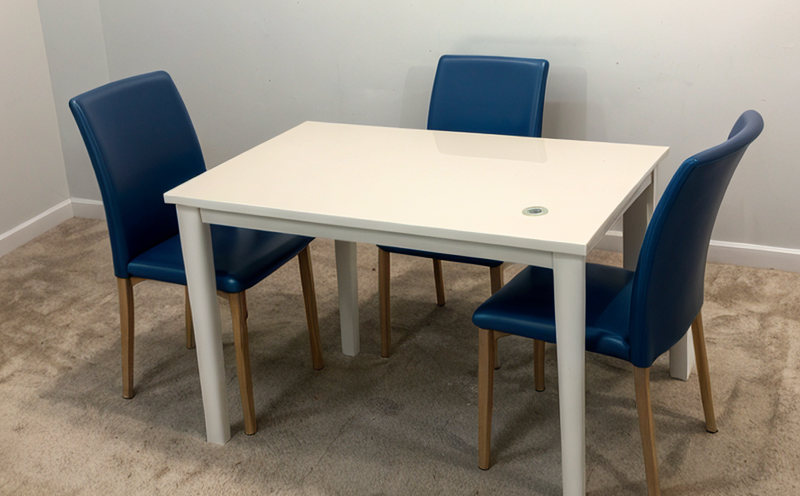ISO 10993-5 Cytotoxicity Testing of Interior Plastics
The ISO 10993-5 standard is a critical component in the regulatory framework for medical devices, ensuring that materials used in contact with human tissue are safe. This test evaluates whether a material can cause cellular necrosis or other harmful effects when in contact with biological fluids such as blood, serum, and plasma.
For interior plastics used in furniture and interiors, this test is particularly important because it ensures the safety of products that may come into prolonged contact with human skin. The test involves exposing a specimen to a physiological salt solution (PSS) for 24 hours at 37°C. After the incubation period, the medium is analyzed for the presence of viable cells and any released substances.
The procedure is designed to identify potential toxic effects early in the product development cycle, allowing manufacturers to address safety concerns before proceeding with further testing or production. This ensures compliance with regulatory requirements and protects end users from exposure to potentially harmful materials.
During specimen preparation, it's crucial to select a representative sample that accurately reflects the final product. The sample should be cut into small pieces of uniform size, ensuring consistent results across multiple test runs. The choice of plastic type (polyethylene, polypropylene, PVC, etc.) and its intended use in furniture can significantly influence the outcome of the test.
The test apparatus typically includes a cell culture incubator capable of maintaining temperatures close to 37°C with precise humidity control. A pH meter is also required to monitor the acidity or alkalinity of the medium during the test period. Once the specimen has been exposed and removed, it must be rinsed thoroughly before analysis.
Following exposure, the medium is centrifuged to separate cellular debris from the solution, which is then analyzed for viable cell counts using a hemocytometer or similar device. Any released substances are also quantified through spectrophotometric assays. These measurements help determine whether the specimen has caused any adverse effects on cell viability.
Results of this test can vary depending on factors such as plastic composition, thickness, and surface finish. For instance, a thin layer of PVC may show higher cytotoxicity compared to thicker specimens made from similar materials but with different additives or fillers. Understanding these variables is key when interpreting the results.
The importance of this test cannot be overstated, especially in industries where product safety and consumer protection are paramount. By adhering to ISO 10993-5 standards during development stages, manufacturers can minimize risks associated with material interactions while fostering innovation through safer designs.
In summary, the ISO 10993-5 test is essential for ensuring that interior plastics used in furniture and other products do not pose a risk to human health. Its rigorous methodology provides valuable insights into potential issues early on, facilitating informed decision-making throughout product development cycles.
Why It Matters
The ISO 10993-5 cytotoxicity test is crucial for ensuring the safety of interior plastics used in furniture and other products that come into prolonged contact with human skin. Non-compliance can lead to adverse health effects, including irritation, inflammation, or even more severe reactions like necrosis.
From a regulatory perspective, adherence to these standards demonstrates commitment to quality control and patient safety, which is increasingly becoming a competitive advantage in the market. Failure to meet such requirements could result in product recalls, legal actions, and damage to brand reputation.
On an operational level, early detection of cytotoxicity issues allows companies to make necessary adjustments during the design phase rather than addressing problems after they become evident. This proactive approach can save significant time and resources by avoiding costly rework or redesign processes later in development cycles.
In addition to meeting legal requirements, implementing robust testing procedures like ISO 10993-5 helps build trust with consumers who increasingly demand transparent supply chains and eco-friendly materials. Companies that prioritize safety early on are more likely to gain customer loyalty and foster positive relationships within the industry ecosystem.
Ultimately, prioritizing cytotoxicity tests ensures long-term success by maintaining high standards across all aspects of product development-from raw material selection through final assembly. It underscores a company's dedication to producing safe, reliable products that contribute positively to society.
Benefits
The ISO 10993-5 cytotoxicity test offers numerous benefits for manufacturers operating in the furniture and interior design sectors. By conducting this test early in the development process, companies can:
- Ensure compliance with international standards and regulatory requirements.
- Identify potential risks associated with new materials or formulations before they are fully integrated into products.
- Reduce the likelihood of product recalls due to safety concerns.
- Promote brand reputation by demonstrating a commitment to quality and consumer protection.
- Gain competitive advantage through superior product performance and reliability.
In addition, implementing this test can help streamline regulatory submissions and reduce the overall cost of bringing products to market. It also allows for continuous improvement in material selection and processing techniques, ensuring ongoing compliance with evolving standards and regulations.
Industry Applications
The ISO 10993-5 cytotoxicity test finds application across various sectors where interior plastics are used in furniture and other products. Some key areas include:
- Furniture manufacturing: Ensuring that materials like polyurethane foam, vinyl upholstery, and particleboard do not pose a risk to human health.
- Home decor: Verifying the safety of decorative items made from plastics or coated with plastic finishes.
- Office furniture: Guaranteeing that seating, desks, and other office equipment are free from harmful substances when in contact with skin.
- Auto interiors: Confirming that fabrics, foams, and coatings used in automotive seating do not release toxic compounds under normal use conditions.
In each of these applications, the test plays a vital role in protecting both manufacturers and consumers by ensuring that interior plastics meet stringent safety criteria established by relevant standards bodies.





